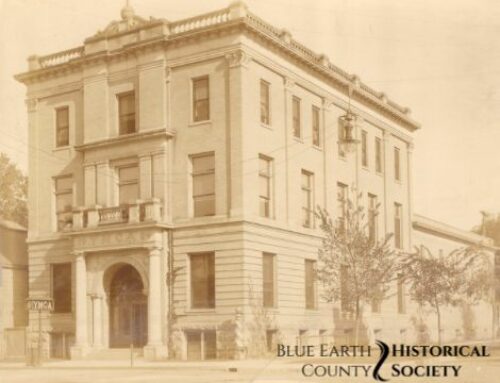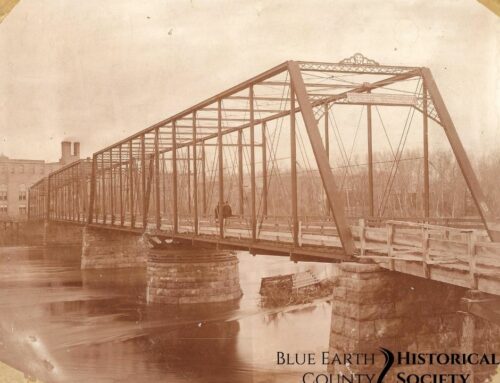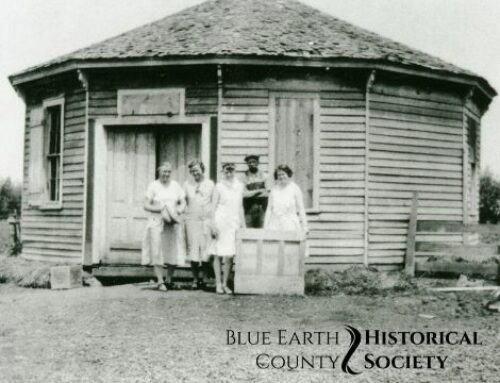Because of the timber and waterways, Cambria is known as one of the most picturesque townships in Blue Earth County. Cambria Township began as a part of Butternut Valley Township, but more settlers came to the area because of the timber, water, and drainage that Cambria became its own township in 1867.
Morris Lewis, David A. Davis, and David Evans made the first claims in Cambria in 1855, but John E. Davis was the first to erect a dwelling out of forked poles and prairie grass, and later the town’s first log cabin. He and his family had arrived from Big Rock, Illinois, driving a covered wagon.
Many more families started arriving at the township over the next years. In May 1856, a large group of Welsh immigrants came and settled. The first birth of a white child was Catherine, daughter of D.J. Davis, in 1857. Another tragedy struck the township when the first death occurred that same year: a young child of the Price family accidentally set itself and its shanty on fire, burning to death.
Settlers struggled through extreme hardship during the winter of 1856-57, which was extremely cold. Two men froze to death on their ten mile trip home from buying provisions for their families. They stopped to drink liquor, became intoxicated, and froze to death after they fell into a stupor.
One of the settlers, David J. Davis, had operated a sawmill at his former town in Ohio, and he went back there to buy a second-hand steam sawmill. During the winter of 1857-58, he used the mill to cut much lumber and grind much corn. The first of this lumber was used to construct the Horeb Church, which was built in 1858, by Andrew Friend and John Davis, and completed with a platform, pulpit, and good seats by William Williams, and the new pastor Rev. David M. Jones, throughout his ministry with them in 1870.
In December of 1856, the town got its official name. There were two suggestions, “Davistown” and “Butternut Valley.” Davistown was suggested after the first settler, and many people supported it, but Col. S. D. Shaw suggested “Butternut Valley” after all the butternut trees in the area, and his eloquent arguments won over enough people to secure the title’s victory.
In 1856, the town was split into three school districts, but residents did not approve of this division, so it was reapportioned into two. In 1859, a log school house was constructed in both districts. Elizabeth Davis taught the first school summer of that same year, in District No. 10.
In 1857, Col. S. D. Shaw became the first postmaster of the post office of “Butternut Valley,” but there was no established mail route, so he was forced to carry the mail on his back. Many postmasters came and went over the next five years, none staying for long until the office was discontinued.
By 1867, the township was gaining many settlers. In fact, new settlers were becoming more populous than the first settlers, and outvoting them in meetings. The older settlers petitioned the County Board to form a new town. The board agreed, and “Cambria” was formed. The name was suggested by George Owens because many of the inhabitants were Welsh (Cymri). The town organized June 3, 1867.
Cambria suffered from many disasters, especially Indian outbreaks, due to its being the frontier town of the county. In 1857, there was a great massacre led by outlawed Wahpaykootay chief Inkpadoota, and conflict between the settlers and the Indians became even tenser in 1862 while the men of Cambria were gone fighting for the Union; however, the efforts of Christian Indians in the area saved the townships from being entirely reduced by the hostile Indian forces. With their voices of reason from positions on councils and their willingness to aid the settlers’ escape efforts, the Christian Indians did much to preserve the people of Cambria and the surrounding towns.
From 1864-69, it was plagued by grasshoppers, which destroyed crops and caused great shortages. In 1877, one of the town’s school buildings burned down, and a few years later, the Congregational Church was torn apart by a cyclone. Throughout the rest of the 19th century, and into the 20th century, Cambria established itself as a small community with a burgeoning creamery industry, a multitude of churches, and a well-preserved sense of pioneer history.





Leave A Comment